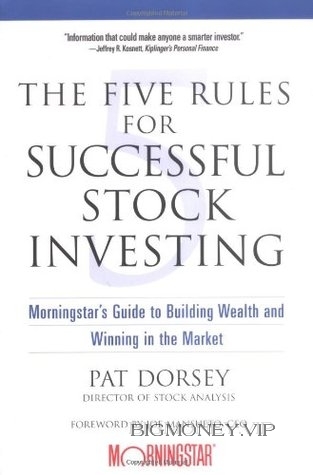
The Five Rules for Successful Stock Investing
IT ALWAYS AMAZES me how few investors—and sometimes, fund
managers—can articulate their investment philosophy. Without an investing
framework, a way of thinking about the world, you’re going to have a very
tough time doing well in the market.
I realized this some years ago while attending the annual meeting of
Berkshire Hathaway, the firm run by billionaire superinvestor Warren Buffett.
I overheard another attendee complain that he wouldn’t be attending another
Berkshire meeting because “Buffett says the same thing every year.” To me,
that’s the whole point of having an investment philosophy and sticking to it. If
you do your homework, stay patient, and insulate yourself from popular
opinion, you’re likely to do well. It’s when you get frustrated, move outside
your circle of competence, and start deviating from your personal investment
philosophy that you’re likely to get into trouble.
Here are the five rules that we recommend:
1. Do your homework.
2. Find economic moats.
3. Have a margin of safety.
4. Hold for the long haul.
5. Know when to sell.
Do Your Homework
This sounds obvious, but perhaps the most common mistake that investors
make is failing to thoroughly investigate the stocks they purchase. Unless you
know the business inside and out, you shouldn’t buy the stock.
This means that you need to develop an understanding of accounting so
that you can decide for yourself what kind of financial shape a company is in.
For one thing, you’re putting your own money at risk, so you should know
what you’re buying. More important, investing has many gray areas, so you
can’t just take someone else’s word that a company is an attractive
investment. You have to be able to decide for yourself because one person’s
hot growth stock is another’s disaster waiting to happen. In Chapters 4
through 7, I’ll show you what you need to know about accounting and how to
boil the analysis process down to a manageable level.
Once you have the tools, you need to take time to put them to use. That
means sitting down and reading the annual report cover to cover, checking out
industry competitors, and going through past financial statements. This can be
tough to do, especially if you’re pressed for time, but taking the time to
thoroughly investigate a company will help you avoid many poor
investments.
Think of the time you spend on research as a cooling-off period. It’s
always tempting when you hear about a great investment idea to think you
have to act now, before the stock starts moving—but discretion is almost
always the better part of valor. After all, your research process might very
well uncover facts that make the investment seem less attractive. But if it is a
winner and if you’re truly a long-term investor, missing out on the first couple
of points of upside won’t make a big difference in the overall performance of
your portfolio, especially since the cooling-off period will probably lead you
to avoid some investments that would have turned out poorly.
Find Economic Moats
What separates a bad company from a good one? Or a good company from a
great one?
In large part, it’s the size of the economic moat a company builds
around itself. The term economic moat is used to describe a firm’s
competitive advantage—in the same way that a moat kept invaders of
medieval castles at bay, an economic moat keeps competitors from attacking a
firm’s profits.
In any competitive economy, capital invariably seeks the areas of
highest expected return. As a result, the most profitable firms find themselves
beset by competitors, which is why profits for most companies have a strong
tendency over time to regress to the mean. This means that most highly
profitable companies tend to become less profitable as other firms compete
with them.
Economic moats allow a relatively small number of companies to retain
above-average levels of profitability for many years, and these companies are
often the most superior long-term investments. Longer periods of excess




